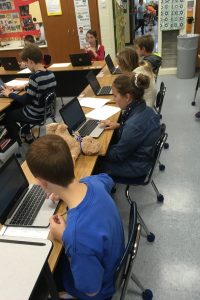Recently I was informed that this week (October 31 – November 4) is media literacy week. Even though I am active in a variety of social and digital media, this was news to me. I am assuming it is to you too, so I thought I would take a moment to share what media literacy is and why it is important for schools.
According to the website medialiteracyweek.us, media literacy is “the ability to ACCESS, ANALYZE, EVALUATE, COMMUNICATE and CREATE using all forms of media.” Literally dozens of educational organizations and technology companies support this definition.
Media literacy is closely related to critical literacy, which “encourages readers to actively analyze texts and offers strategies for what proponents describe as uncovering underlying messages” (Source: Wikipedia). Both media literacy and critical literacy go beyond how we traditionally teach literacy in schools, which includes learning how to read and write and identifying the reasons for engaging in text.
Why is this important?
The main purpose of public education is to learn, as well as to learn how to learn. A student’s educational endeavors should not end after they graduate from high school or college. They need the skills and strategies that will help them be both a critical consumer and thoughtful contributor of information in today’s connected world. One thing we know for sure is technology is not going away. With that, here is how our school has started addressing media literacy in the classroom.
Social media and family communications
A number of classroom teachers have started using social media and other digital tools to communicate their products and processes. For example, one of our kindergarten teachers regularly posts student work and learning activities in a private Facebook page. She uses this social media tool to communicate what is happening in the classroom, deliver announcements to families, and post questions that people at home can ask their kids. Two 2nd grade teachers also use a digital communication tool called ClassDojo. Like Facebook, families see their child’s work and learning activities in a digital space. They can “like” an artifact and comment on the post. While media literacy skills are not explicitly taught at these younger grades at this time, positive and thoughtful online behaviors are being modeled for the students.
Learning management systems and digital collaboration
 5th grade classrooms are connecting with similar age students in Italy and England. Students and teachers are using Google Classroom, a learning management system, to communicate and collaborate with peers on another continent. The purpose of this global partnership is to “facilitate innovative and creative use of technology in classrooms and build friendships with students around the world” (Source: JDO Foundation website). At these more advanced grades, students are immersed in projects that require kids to take another person’s perspective and collaborate in online spaces. They will have to analyze and evaluate the work they create before communicating it for a broader audience. These types of activities closely resemble much of the real work that adults do in their professional lives.
5th grade classrooms are connecting with similar age students in Italy and England. Students and teachers are using Google Classroom, a learning management system, to communicate and collaborate with peers on another continent. The purpose of this global partnership is to “facilitate innovative and creative use of technology in classrooms and build friendships with students around the world” (Source: JDO Foundation website). At these more advanced grades, students are immersed in projects that require kids to take another person’s perspective and collaborate in online spaces. They will have to analyze and evaluate the work they create before communicating it for a broader audience. These types of activities closely resemble much of the real work that adults do in their professional lives.
One of the disadvantages to assigning an important concept such as media literacy to a “day” or “week” is that it might promote the idea that these skills should be taught only at certain times of the year and separate from the core curriculum. Our teachers have been smart about integrating these technologies with the content areas while using effective instruction to deepen student understandings. If you have suggestions or questions about our work with media literacy, please let us know.
MATT RENWICK
PRINCIPAL, ELEMENTARY SCHOOL
This is Matt’s seventeenth year in public education. He started as a 5th and 6th grade teacher in a country school outside of Wisconsin Rapids, WI. After seven years of teaching, Matt served as an assistant principal, athletic director, and building principal all in Wisconsin Rapids. Now as an elementary principal with the Mineral Point Unified School District, he continues to enjoy working with students, staff, and families in their collective pursuit of lifelong learning.

